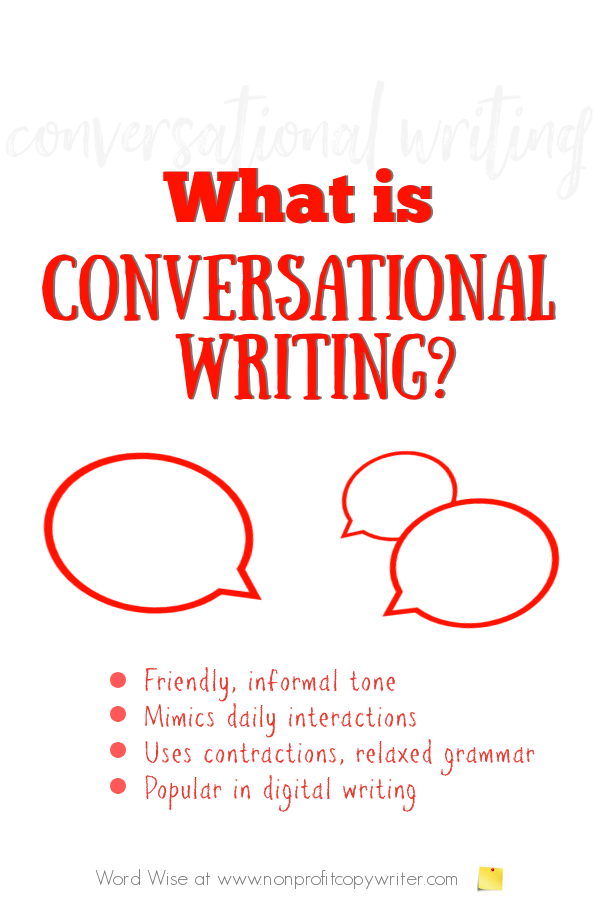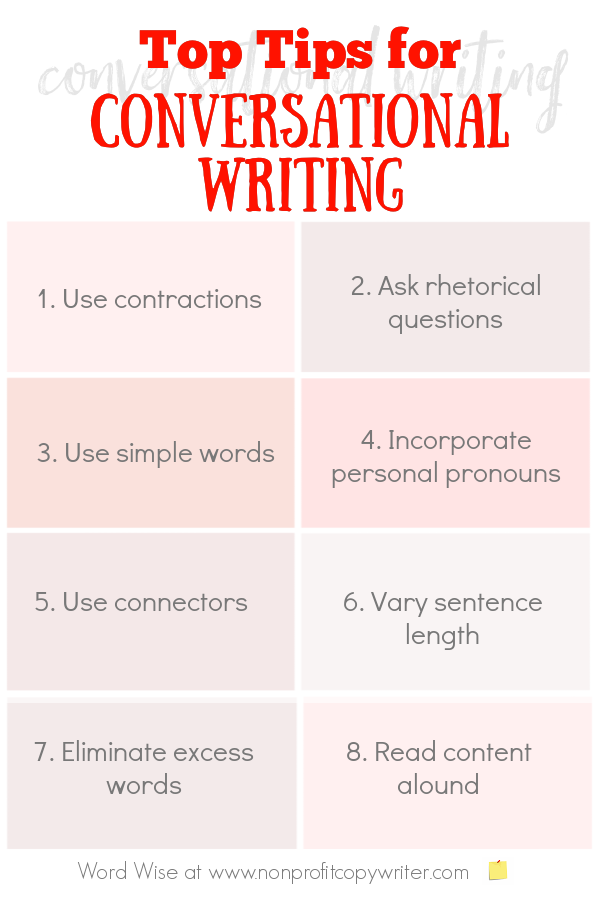Save Time: Get 5 Simple Writing Tips
you can put to use in 10 minutes
Why You MUST Master a Conversational Writing Style
Award-winning writer Kathy Widenhouse has helped hundreds of nonprofits and writers produce successful content , with 750K+ views for her writing tutorials. She is the author of 9 books. See more of Kathy’s content here.
Posted 7.11.24
There’s a reason why conversational writing style has become mainstream. Write conversationally and people can understand what you say. But write in a more formal voice and you confuse your reader (at best) or alienate him (much worse).
Let’s demonstrate. Which description is easier to understand – Version #1 or Version #2?
- Version #1: The advent of the internet and the proliferation of digital communication platforms like email, blogs, and social media significantly contributed to the popularity of conversational writing, emboldening more personal and immediate forms of communication, making a conversational tone more suitable and effective.
- Version #2: As people started using the internet, they started writing more conversationally.
When I read Version #1, I feel like I should be wearing a tux or evening gown – at the very least, business attire. Version #2? I’m in a t-shirt and cut-off shorts.
If I write formally in the style of Version #1, I can use as many words as I want to thoroughly explain the rise of conversational writing. Since I give myself free rein, I can share every itsy-bitsy detail that I’ve accumulated over my 20+ years of writing – including all the twenty-dollar vocabulary words in my arsenal. But what about my readers? When they run across my content written in a formal style, they have to work hard to understand my point.
Don’t let Version #2’s simplicity scare you off. Yes, readers take you seriously when you write conversationally – because they understand you.
What is a conversational writing style?
A conversational writing style is characterized by a friendly, informal tone that makes the reader feel like the writer is talking directly to them. When you write conversationally, you mimic how you speak in everyday interactions. It’s a style that makes generous use of contractions, rhetorical questions, and relaxed grammar over rigid rules.
Think t-shirt rather than a tux.
Why should you master a conversational writing style?
Frankly, because everybody is doing it.
Shrinking attention spans means you need to engage readers quickly. Conversational writing grabs attention and keeps readers interested.
Plus, readers value authenticity. Conversational writing conveys sincerity and builds trust, which helps you develop relationships on paper. And a conversational writing style is versatile which means it’s adaptable across various platforms and contexts, from blogs to social media to customer emails.
But the biggest reason to become adept at writing conversationally? So you can communicate clearly. And by that, I don’t mean just writing short.
Rather, conversational writers are experts at stripping done principles to their core so that the reader has just enough information to grasp even a complex topic. “The few appreciate brilliance,” says Brian Clark, founder of Copyblogger. “But everyone appreciates clarity.”
When to use a conversational writing style
Conversational writing is now the norm. We can thank the rise of the internet and social media for that. Users found they liked talking directly with readers. And without a publishing house go-between, those conversations can happen nearly in real time.
In particular, a conversation writing style is what you find in …
- Blogs and websites. Online content benefits from a personal touch, making information more relatable and engaging.
- Marketing and advertising content. Email campaigns, landing pages, online brochures — a conversational writing style makes ads and promotional content more appealing to readers, creating a sense of trust and connection. Communication feels more personalized and less robotic when you banter back and forth with a reader rather than try to sell them.
- Social media. Platforms like X, Facebook, and Instagram thrive on quick, engaging posts that conversational writing excels at delivering.
- Books. Conversational writing is de rigueur for both electronic and print books as users look for quick reads and consumable content.
When to use a formal writing style
While a conversational writing style has become a writer’s typical MO, there are situations where it’s not the best approach. In these instances, formal prose is expected.
- Academic writing: papers, theses, and research articles must adhere to strict style guides and emphasize precision, objectivity, and professionalism. Conversational writing can be seen as too informal and may not meet the expectations of academic reviewers or readers.
- Legal documents: contracts, petitions, agreements, memos (pretty much anything that my son, an attorney, churns out for the court and his clients) need to be clear, precise, and unambiguous. Dear son and his legal colleagues use formal language to avoid misunderstandings and prevent further lawsuits.
- Technical writing: manuals, user guides, and scientific reports convey complex information clearly and accurately. Important when you’re putting together that bike on Santa’s behalf on Christmas Eve.
- Professional correspondence: a casual tone in job applications, cover letters, official business letters, and forms is unprofessional.
- Government documents: official communications from government agencies, institutions, or formal organizations require — well, formality — to demonstrate authority.
- Healthcare and medical writing: patient reports, medical research, clinical trials documentation — these need clarity, to be sure, but also must adhere to strict standards so they can be read by other professionals in the field. My daughter, a physical therapist, spent an entire semester in medical school learning to write notes so other providers understand her patients’ presentations and treatment plans.
- Financial documents: annual reports, audit reports, and financial statements are filled with more than numbers. They need verbal clarity for investors, stakeholders, and regulatory bodies who make all kinds of important decisions that affect the rest of us who are mathematically-challenged.
The difference between formal writing and a conversational writing style: an example
To illustrate the differences between a formal writing style and a conversational writing style, let’s compare them.
Formal writing example
Subsequent to the aforementioned meeting, it was determined that a comprehensive review of the project will be conducted. This review will encompass all relevant aspects, ensuring adherence to established guidelines and protocols.
Conversational writing example
After our meeting, we decided to review the project thoroughly. We’ll look at everything to make sure we’re following the rules.
The key differences I see: the conversational writing example is shorter, has simpler words, avoids passive voice, uses first person POV, and is easier to digest — but still communicates the point.
Simple conversational writing techniques you can use right now
Even though a conversational writing style has become the norm, many writers hide behind a formal tone. It’s what you were taught in school, so you stick with it. If that’s you, then try these conversational writing tips.
- Use contractions. Write don’t rather than do not … we’ll rather than we will.
- Ask rhetorical questions. You do it in verbal conversations all the time, right?
- Use simple words. Where possible, choose the word with fewer letters and syllables. For instance, replace utilize with use.
- Incorporate personal pronouns. Write in first and second-person POVs. Use I, you, we, and us to create a direct connection with your reader.
- Use connectors. It’s okay to start a few sentences with and, but, so, or yet — just like you do when you talk.
- Vary your sentence length. Short sentences can add impact, while longer ones can provide depth. And throw in a few sentence fragments, too. You’re not submitting your content to get a grade. You’re writing to help your reader understand a point.
- Eliminate excess words. If you don’t need it, delete it. If you can reduce a 3-word phrase to 1 word, do so. If a word or a phrase or a thought doesn’t advance your main idea, strip it away. As one writer put it, “We must be masters of exclusion.”
- Read your content aloud. Pretend you’re sitting across the kitchen table from a friend. Read your work to him. You’ll catch awkward phrasing and words that you’d normally not use when you talk.
The biggest challenge to using a conversational writing style
The biggest challenge to writing conversationally? Your expertise.
Being knowledgeable about your topic is a double-edged sword. On the one hand, you’ve accumulated all kinds of luscious information from your research and your experience. You’ve got a wonderful well of information to draw upon for your readers.
But that can make you succumb to the “curse of knowledge,” as described by Chip and Dan Heath in Made to Stick. You can’t remember what it was like not to know the things you know now. So you write lengthy summaries twisted with convoluted explanations using jargon that only insiders understand. Since you’re immersed in your niche, this language is normal for you. You’ve got information pouring out of you and you simply cannot exercise restraint in sharing any of it. As a result, your reader is overwhelmed.
Or maybe you know just a little bit more than the Average Joe. So you set about to impress him rather than communicate with him. Your goal is to show off to Joe, rather than help him understand. But your content does neither. You’re stuck in a tux … and Joe loses.
Your job, as a writer, is to take the complex and make it accessible to Average Joe. Conversational writers make the profound sound simple. Remember — Joe wears a T-shirt.
American writer Elmore Leonard (1925–2013) summarized the process well in a 2001 New York Times article. “If it sounds like writing,” he said, “I rewrite it.”
Do the same.
More Conversational Writing Tips
3 Ways to Write Conversationally ...
The Top Online Writing Tip: Write Conversationally ...
Run-On Sentences Can Be Your Friend. Fragments, Too...
19 Practical Conversational Writing Tips ...
More Quick Writing Tips on our Pinterest board ...
Return from Master Conversational Writing and Build a Following Faster
to Nonprofit Copywriter home
As an Amazon Associate I earn from qualifying purchases.
Share This Page

Named to 2022 Writer's Digest list
BEST GENRE/NICHE WRITING WEBSITE


Stop Wasting Time!
Grab your exclusive FREE guide, "5 Simple Writing Tips You Can Put to Use in 10 Minutes or Less"













